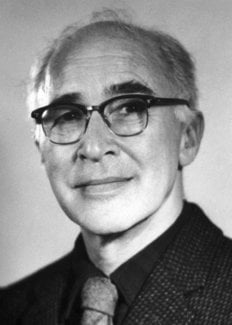George Wald
Biographical

George Wald was born in New York City on November 18th, 1906, of immigrant parents, Isaac, who had come from a village near Przemysl, in what was then Austrian Poland, and Ernestine Rosenmann, from a small village near Munich, in Bavaria. After attending public primary and secondary I schools in Brooklyn, he received the degree of Bachelor of Science from Washington Square College of New York University in 1927; and then took graduate work in zoology at Columbia University, from which he received the Ph.D. in 1932. During this graduate period he was a student and research assistant of Professor Selig Hecht.
On receiving the Ph. D. he was awarded a National Research Council Fellowship in Biology (1932-1934). This was begun in the laboratory of Otto Warburg in Berlin-Dahlem and it was there that Dr.Wald first identified vitamin A in the retina. Vitamin A had just been isolated in the laboratory of Professor Paul Karrer in Zurich, and Dr. Wald went to Karrer’s laboratory to complete the identification. That done, he spent a period in the laboratory of Otto Meyerhof, at the Kaiser Wilhelm Institute in Heidelberg. The second year of the fellowship was spent in the laboratories of the Department of Physiology at the University of Chicago.
Dr. Wald came to Harvard in the fall of 1934 as a tutor in Biochemical Sciences and has been there ever since; as Instructor and Tutor in Biology (1935-1939); Faculty Instructor (1939-1944); Associate Professor (1944-1948); and Professor of Biology (since 1948). He was visiting Professor of Biochemistry at the University of California for the summer term, 1956.
In 1939 Dr. Wald received the Eli Lilly Award for «Fundamental Research in Biochemistry» from the American Chemical Society. In 1952 he toured the Southwest as a National Sigma Xi lecturer. In 1953 he received the Lasker Award of the American Public Health Association «in recognition of his outstanding discoveries in biochemistry with special reference to the changes associated with vision and the function of vitamin A».In 1955 he was awarded the Proctor Medal of the Association for Research in Ophthalmology, and in 1959 the Rumford Medal by the American Academy of Arts and Sciences. In 1966 he was awarded the Ives Medal of the Optical Society of America; and in May, 1967, jointly with his wife Ruth Hubbard, the Paul Karrer Medal by the University of Zurich. In 1967 he was awarded the T. Duckett Jones Memorial Award from the Whitney Foundation.
Dr. Wald was elected to the National Academy of Sciences in 1950 and to the American Philosophical Society in 1958. He is a Fellow of the American Academy of Arts and Sciences in Boston, and of the Optical Society of America. In 1963-1964 he was a Guggenheim Fellow, spending the year at Cambridge University, England.
In 1957 Dr. Wald received the honorary degree of M. D. from the University of Berne; in 1958 an honorary D. Sc. from Yale University; in 1962 honorary D. Sc. from Wesleyan University; in 1965 honorary D. Sc. from New York University; in 1966 honorary D. Sc. from McGill Univ.; 1968 D. Sc. from Clark Univ. and from Amherst College.
Dr. Wald is a member of the American Society of Biological Chemists; the Optical Society of America; the Assoc. for Research in Ophthalmology; Sigma Xi; American Chemical Society; and the A.A.A.S.
This autobiography/biography was written at the time of the award and first published in the book series Les Prix Nobel. It was later edited and republished in Nobel Lectures. To cite this document, always state the source as shown above.
George Wald died on April 12, 1997.
Nobel Prizes and laureates
Six prizes were awarded for achievements that have conferred the greatest benefit to humankind. The 12 laureates' work and discoveries range from proteins' structures and machine learning to fighting for a world free of nuclear weapons.
See them all presented here.
